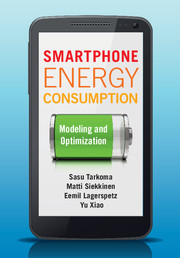Book contents
- Frontmatter
- Contents
- Preface
- List of abbreviations
- Part I Understanding energy consumption
- Part II Energy management and conservation
- Part III Advanced energy optimization
- 11 Overview
- 12 Traffic scheduling
- 13 Exploiting multiple wireless network interfaces
- 14 Mobile cloud offloading
- 15 Example scenarios for energy optimization
- 16 Future trends
- Appendix A An energy profile application
- Index
- References
15 - Example scenarios for energy optimization
from Part III - Advanced energy optimization
Published online by Cambridge University Press: 05 August 2014
- Frontmatter
- Contents
- Preface
- List of abbreviations
- Part I Understanding energy consumption
- Part II Energy management and conservation
- Part III Advanced energy optimization
- 11 Overview
- 12 Traffic scheduling
- 13 Exploiting multiple wireless network interfaces
- 14 Mobile cloud offloading
- 15 Example scenarios for energy optimization
- 16 Future trends
- Appendix A An energy profile application
- Index
- References
Summary
We now turn our attention from individual optimization techniques to applications. We investigate a few different cases where the principles and techniques we have learned earlier can be applied in mobile applications.
We first look at a specific application, namely video streaming, which is one of the most important internet applications today, from the mobile internet's perspective. We first study the way that video streaming consumes energy and illustrate that through measurement results from real systems. We then cover different strategies that can be used to save energy in video streaming. It turns out that there are a few things that need to be taken into account when applying generic energy-saving techniques to mobile video streaming.
The next two examples are not really specific applications but rather integral parts of many applications and, therefore, they represent extremely important cross-application scenarios. The first of those is sensing. Sensing is a hot research topic at the moment and it is expected to become a very important part of smartphone applications. We study ways to reduce energy consumption with applications that require different kinds of sensing by exploring separately each category of sensors included in modern smartphones. We focus on two well-established techniques: sensor selection and duty cycling.
The second cross-application energy optimization scenario is security. We look at the energy overhead caused by security protocols and algorithms, based on measurement studies. Then, we discuss whether and when it is possible to find a tradeoff between the level of security and energy consumption.
- Type
- Chapter
- Information
- Smartphone Energy ConsumptionModeling and Optimization, pp. 297 - 314Publisher: Cambridge University PressPrint publication year: 2014



